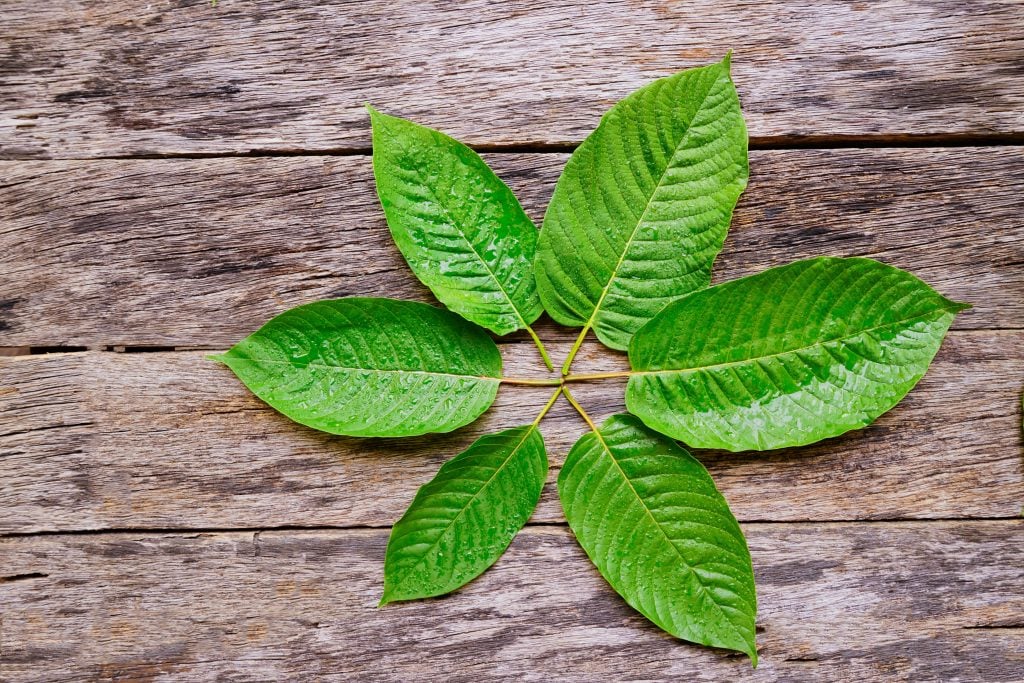Alkaloids are the active compounds in kratom, responsible for most of its effects. These compounds aren’t unique to kratom, though, and are a form of defense many plants use against predators. Because of this, some alkaloids aren’t good for humans. Humans regularly use many alkaloids, though, from quinine in tonic water (and some malaria treatments) to caffeine in your morning coffee.
Kratom’s alkaloids: Mitragynine & 7-OH
The main alkaloid in kratom is called mitragynine, and dry kratom leaves can contain up to just over two percent of this compound. In general, the other alkaloids present in kratom in trace amounts aren’t as active as mitragynine. A more potent alkaloid, 7-hydroxymitragynine (sometimes called 7-OH), is a variant of mitragynine that naturally occurs in much lower concentrations in kratom leaves.
Kratom’s alkaloid content can change significantly depending on how the kratom is grown, where it is grown, and what the growth environment is like. Contrary to popular belief, no matter how kratom is grown, it isn’t possible to “alkalize” blood with kratom. Moreover, having an increased amount of alkaloids or alkaline substances in the body does not inherently make people healthier.
How are alkaloids produced?
Most alkaloids in plants are formed when plant tissues are young and still actively growing. Younger tissues can be much more susceptible to environmental changes and stresses than older parts of a plant. There are many different factors that influence which alkaloids a plant produces, and how much of that alkaloid a plant makes at any given time.
Alkaloids are connected to specific gene pathways, and any external influence on those pathways can affect production. Light, temperature, and soil content can all affect how kratom and other plants produce alkaloids.
We don’t know exactly how every alkaloid in kratom is produced, but we do know that they come from interactions of multiple different biological pathways. These pathways, even if they’re almost exactly the same, can affect different plant species in different ways.
A mineral which increases alkaloid content in one plant in a certain pathway might have the opposite effect in a similar pathway in another plant. There are some general environmental characteristics that tend to affect alkaloid content in certain ways, though, and those are the ones this article focuses on.
Environmental factors
If a plant is exposed to higher levels of nitrogen, either in water or in soil, the amount of alkaloids it produces tends to go up. At a certain point, this effect doesn’t become significant anymore, but enriching kratom with compounds that have nitrogen in them is potentially a good way to augment the plant’s final alkaloid content.
An increase in nitrogen hasn’t been connected to a specific alkaloid, so it’s not possible to isolate and increase levels of certain compounds. Another interesting effect of adding nitrogen to plants is that they seem to grow much better. This isn’t related to the alkaloid content; the plants grow better because nitrogen is an essential nutrient for them.
An increase in sunlight is an will likely increase alkaloid content in many plants. Exactly how much sunlight a plant needs for the highest possible alkaloid production depends on the type of plant and how it’s grown. In the laboratory, plants given 12 hours of constant sunlight, followed by 12 hours of darkness, had the largest increase in alkaloids, but this is probably different for kratom. Experimenting with the amount of light during the kratom growing process won’t affect the plants in a negative way unless they get very little light.
Higher temperatures have different effects on alkaloid production, depending on the plant, and so does the amount of carbon dioxide in the air. It isn’t clear whether carbon dioxide itself changes the amount of alkaloids in plants, even though carbon dioxide is an important part of photosynthesis. Based on current research, it’s more likely that an increase in carbon dioxide in the air increases temperature, which causes the change in alkaloid content.
Soil components
The type of bacteria in the soil can have a major effect on how much alkaloid a plant produces. Certain types of bacteria stimulate plants to create more alkaloids. These bacteria often make the plants bigger as well, and help them create more extensive root systems.
Alkaloid concentrations also increase if plants are grown in soil that has a high salt content. This can lead to mixed results, though, because salt in the soil also puts a lot of stress on plants. They don’t grow as well in salty soil, and young tissues are impacted in negative ways.
As these two examples show, manipulating alkaloid content in kratom by how it’s grown is definitely possible. But it needs to be done safely, with understanding of how the process might affect the plant and the people who want to use it. Kratom grows perfectly well without these interventions, and we think natural is best!
Closing
More research needs to be done specifically on kratom alkaloids, but its component compounds seem to react similarly to the alkaloids in other plants. Some of these methods are easy, like increasing sunlight and making sure not to use certain chemicals on the plants. Increasing nitrogen content of the soil, adding bacteria, or carefully controlling temperature might be much more challenging. There are many factors that affect alkaloid content in kratom, and it’s a complex task to create an ideal growing environment!
